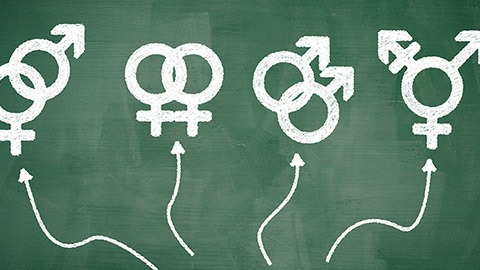Editor’s Summary: This article provides a balanced review of the factors influencing sexual orientation, examining both genetic (nature) and environmental (nurture) aspects. It discusses key studies, including twin studies, chromosome studies, and genome-wide association studies, as well as neurobiological research and prenatal hormone theories. The review highlights the complexities and challenges in defining and researching sexual orientation, concluding that it is shaped by a multifaceted interplay of genetic, biological, and environmental influences.
The Role of Nature and Nurture in Sexuality: A Balanced Review

Abstract
This article reviews the current scientific understanding of the factors influencing sexual orientation, focusing on the interplay between genetic (nature) and environmental (nurture) influences. By examining key studies and their methodologies, we aim to provide a balanced perspective on this complex topic. The review highlights the multifaceted nature of sexual orientation and the challenges in determining its precise origins.
Introduction
The origins of sexual orientation have been a subject of scientific inquiry and societal debate for decades. This review aims to present an objective summary of current research on the roles of nature (genetic and biological factors) and nurture (environmental and social influences) in shaping sexual orientation.
Genetic Factors
Several studies have explored the genetic basis of sexual orientation:
- Twin Studies: Research by Bailey and Pillard (1991) found that among identical twins, if one twin was gay, there was a 52% chance the other would be as well. This concordance rate dropped to 22% for fraternal twins. While these findings suggest a genetic component, they also indicate that genes alone do not determine sexual orientation.
- Chromosome Studies: Hamer et al. (1993) identified a region on the X chromosome (Xq28) that appeared to be linked to male homosexuality. However, subsequent studies have had mixed results in replicating these findings (Rice et al., 1999).
- Genome-Wide Association Studies: Recent large-scale studies (Ganna et al., 2019) have identified multiple genetic markers associated with same-sex behavior, but no single “gay gene” has been found. These studies suggest that many genes, each with small effects, may influence sexual orientation.
Biological Factors
Neurobiological research has also contributed to our understanding:
- Brain Structure: LeVay (1991) found differences in the size of certain brain structures between heterosexual and homosexual men. However, the study had limitations, including a small sample size and the inability to determine if these differences were causes or effects of sexual orientation.
- Prenatal Hormones: Some research suggests that prenatal hormone exposure may influence sexual orientation. For example, Bogaert (2006) found a correlation between number of older brothers and male homosexuality, hypothesizing a maternal immune response affecting fetal development.
Environmental Factors
While genetic and biological factors play a role, environmental influences are also important:
- Family and Peer Influences: Social learning theories suggest that family dynamics and peer interactions may influence sexual orientation development. However, most researchers agree that sexual orientation is not a choice or simply learned behavior.
- Cultural Context: Attitudes towards sexuality and gender roles vary across cultures, potentially influencing how individuals express and understand their sexual orientation.
- Early Experiences: Some studies have explored the potential impact of early sexual experiences on orientation, but causal relationships are difficult to establish.
Challenges in Research
Several factors complicate research in this area:
- Definition and Measurement: Sexual orientation is complex and can be defined and measured in various ways, making comparisons between studies challenging.
- Sample Bias: Many studies rely on volunteer participants, potentially leading to non-representative samples.
- Ethical Considerations: The sensitive nature of the topic and potential for misuse of findings require careful ethical consideration in research design and reporting.
Integrated Perspective
Current scientific consensus suggests that sexual orientation results from a complex interplay of genetic, biological, and environmental factors. The American Psychological Association (2008) states: “There is no consensus among scientists about the exact reasons that an individual develops a heterosexual, bisexual, gay or lesbian orientation. Although much research has examined the possible genetic, hormonal, developmental, social, and cultural influences on sexual orientation, no findings have emerged that permit scientists to conclude that sexual orientation is determined by any particular factor or factors.”
Conclusion
The origins of sexual orientation remain a topic of ongoing research and debate. While evidence suggests both nature and nurture play roles, their exact contributions and interactions are not fully understood. Future research may benefit from interdisciplinary approaches that consider the complex interplay of biological, psychological, and social factors in shaping sexual orientation.
References
- American Psychological Association. (2008). Answers to your questions: For a better understanding of sexual orientation and homosexuality.
- Bailey, J. M., & Pillard, R. C. (1991). A genetic study of male sexual orientation. Archives of General Psychiatry, 48(12), 1089-1096.
- Bogaert, A. F. (2006). Biological versus nonbiological older brothers and men’s sexual orientation. Proceedings of the National Academy of Sciences, 103(28), 10771-10774.
- Ganna, A., et al. (2019). Large-scale GWAS reveals insights into the genetic architecture of same-sex sexual behavior. Science, 365(6456).
- Hamer, D. H., et al. (1993). A linkage between DNA markers on the X chromosome and male sexual orientation. Science, 261(5119), 321-327.
- LeVay, S. (1991). A difference in hypothalamic structure between heterosexual and homosexual men. Science, 253(5023), 1034-1037.
- Rice, G., et al. (1999). Male homosexuality: Absence of linkage to microsatellite markers at Xq28. Science, 284(5414), 665-667.